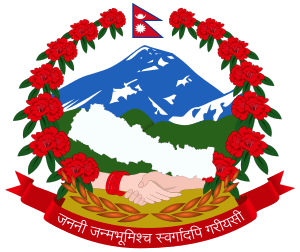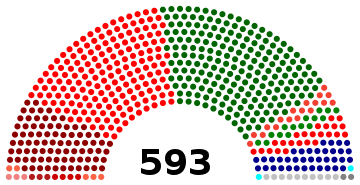Legislature Parliament of Nepal
| Second Constituent Assembly of Nepal व्यवस्थापिका संसद | |
|---|---|
 | |
| Type | |
| Type | |
| History | |
| Founded | 21 January 2014 |
| Disbanded | 19 January 2018 |
| Preceded by | first Constituent Assembly |
| Succeeded by | Parliament of Nepal |
| Leadership | |
Speaker(s) |
Subash Chandra Nembang, Communist Party of Nepal (Unified Marxist–Leninist) 21 January 2014- 16 October 2016 Onsari Gharti Magar, Communist Party of Nepal (Maoist Centre) 16 October 2015- 14 October 2017 |
| Structure | |
| Seats | 601 |
 | |
Political groups |
Rastriya Prajatantra Party Prajatantrik: 18 seats
|
Length of term | Four years |
| Elections | |
| Mixed member majoritarian (first past the post for 240 members, proportional representation for 335 members, and 26 members appointed by the Prime Minister) | |
Last election | Nepalese Constituent Assembly election, 2013 |
Next election | Nepalese legislative election, 2017 (House of Representatives) |
| Website | |
| http://www.parliament.gov.np/ | |
Second Constituent Assembly of Nepal (Nepali: व्यवस्थापिका संसद) was the unicameral legislature of Nepal.[1] It was formed as the result of the 2013 Constituent Assembly elections after the failure of the first Constituent Assembly to promulgate a new constitution.[2] The legislature ended its term on 14 October 2017.[3]
Opening
Former Prime Minister Surya Bahadur Thapa, the oldest member of the house, assumed chairmanship of the CA on January 20, 2014[4] and administered the oath of office to 565 lawmakers at the first meeting of the assembly on January 21, 2014.[5] Leaders of the NC, CPN-UML and UCPN (Maoist) pledged to draft a new constitution within a year.[6] More than 80% of the members are new faces.[7]
Power-sharing discussions
On January 26, 2014, President Ram Baran Yadav called for the election of a Prime Minister and the formation of a consensus government within a week[8] as per article 38(1) of the constitution which provides for the formation of a government through political understanding.[9] The Nepali Congress obtained the support of the CPN-UML for a NC-led consensus government[10] and the two parties also agreed to hold local body elections within six months and adopt a new constitution within a year.[11] An all-party meeting followed at which the CPN-UML, UCPN (Maoist) and MPRF-Loktantrik expressed support for a government under Sushil Koirala. The RRP-N boycotted the meeting.[12] Further discussions were held between the NC, CPN-UML and UCPN (Maoist) at which the Maoists expressed support for the idea of a NC-led government but did not agree to join the government and decided to stay in opposition.[13] On February 2, 2014, the NC abandoned its pursuit of a consensus government under article 38(1) of the constitution after the UCPN (Maoist) and RPP-N, the third and fourth largest parties, decided not to join the government. The party has initiated talks with the CPN-UML to form a majority government under article 38(2) of the constitution.[14][15]
Composition
A total of thirty political parties and two independents were represented at the start of the second constituent assembly. However, some parties have merged and the number of parties has declined.[16][17]
Committees[23]
- State Affairs Committee
- Public Accounts Committee
- Environment Protection Committee
- International Relations and Labour Committee
- Legislation Committee
- Good Governance and Monitoring Committee
- Industry Commerce and Consumer Welfare Committee
- Women, Children, Senior Citizen and Social Welfare Committee
- Development Committee
- Agriculture and Water Resources Committee
- Finance Committee
- Parliamentary Hearing Special Committee
References
- ↑ "Constituent Assembly". Constituent Assembly of Nepal. Archived from the original on 21 January 2014. Retrieved 22 January 2014.
- ↑ "CA dissolved; PM proposes fresh election for Nov 22". eKantipur. 28 May 2012. Archived from the original on 2 April 2015. Retrieved 22 January 2014.
- ↑ "सकियो ५ सय ९२ सांसदको कार्यकाल, आजैदेखि पूतपूर्व". Sajha Post. Retrieved 25 October 2017.
- ↑ "Thapa assumes office as head of CA". My Republica. 20 January 2014. Retrieved 22 January 2014.
- ↑ "565 CA members sworn in, first CA meet today". My Republica. 22 January 2014. Retrieved 22 January 2014.
- ↑ "Nepal takes step towards new constitution. Political leaders pledge to draw up constitution within a year as new parliament convenes". Al Jazeera. 23 January 2014. Retrieved 24 January 2014.
- ↑ "Nepal's new lawmakers pledge early charter". China Daily. 21 January 2014. Retrieved 24 January 2014.
- ↑ "Prez Yadav calls for govt formation before Feb 2". eKantipur. 26 January 2014. Retrieved 27 January 2014.
- ↑ "Prez gives parties a week to form new govt". MyRepublica. 26 January 2014. Retrieved 27 January 2014. "Article 38 (1) states, 'The Council of Ministers shall be formed under the chairmanship of the Prime Minister, on the basis of political understanding.'... Article 38 (2) states,' Failing to forge an understanding as referred to in clause (1), the Prime Minister shall be elected by a majority of the total number of the then members of the Legislature-Parliament'."
- ↑ "NC-UML meet ends, UML to support NC-led consensus govt". MyRepublica. 27 January 2014. Retrieved 27 January 2014.
- ↑ "UML ready to support Koirala". eKantipur. 27 January 2014. Retrieved 27 January 2014. 'Singh further informed that the discussions between the two parties, held right after the second meeting of Legislature Parliament, culminated with the resolution on holding the local body election within six months and promulgating the constitution within a year. "Both the parties have agreed to hold the local body election within six months," Singh said, "A consensus has also been reached to draft the new constitution within one year."'
- ↑ "NC holds all party meet, seeks support for NC-led govt". Gorkhapatra. 28 January 2014. Retrieved 28 January 2014.
- ↑ "Three-party meeting ends". My Republica. 28 January 2014. Retrieved 28 January 2014.
- ↑ "NC asks prez to initiate process for majority govt". My Republica. 3 February 2014. Retrieved 3 February 2014.
- ↑ "UCPN (M) decides not to join govt". eKantipur. 28 January 2014. Retrieved 28 January 2014.
- ↑ Ansari, Gani (3 December 2013). "EC allocates PR seats; 30 parties in new CA". My Republica. Retrieved 23 January 2014.
- ↑ http://kathmandupost.ekantipur.com/news/2017-04-30/ruling-coalition-morcha-file-constitution-amendment-bill.html
- ↑ "Koirala elected as NC PP leader". My Republica. 26 January 2014. Retrieved 26 January 2014.
- ↑ "Oli elected as UML PP leader". eKantipur. 4 February 2014. Retrieved 4 February 2014.
- ↑ "Dahal picked as UCPN (Maoist) PP leader". My Republica. 28 January 2014. Retrieved 28 January 2014.
- ↑ "Kamal Thapa is PP leader of RPP-N". eKantipur. 21 January 2014. Archived from the original on 22 January 2014. Retrieved 23 January 2014.
- ↑ "Six Madhes-based parties unite to form Rastriya Janata Party (Update)". Retrieved 2017-09-30.
- ↑ "समितिहरु". Retrieved 17 September 2017.